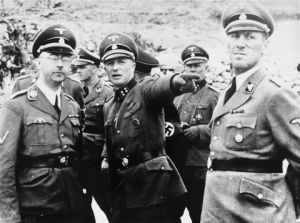Ernst Kaltenbrunner

Himmler, Zieries, Kaltenbrunner in Mauthausen Concentration Camp
Ernst Kaltenbrunner was born on 4 October 1903 in the valley of the Inn, near Braunau, the birthplace of Adolf Hitler. He was descended from a family of country artisans, although his father and grandfather were lawyers. He was educated in Linz, and one of his boyhood friends was Adolf Eichmann. Kaltenbrunner subsequently studied law at Graz University. He took up his doctorate in law in 1926, setting up his practice as a lawyer in Linz.
Kaltenbrunner played an active role in one of the first groups of Austrian National Socialist students and for a time a militant in the Independent Movement for a Free Austria. He eventually joined the Nazi Party in 1932. A year later he became a member of one of the more or less camouflaged SS organisations in Austria and a spokesman for the Nazi Party in Upper Austria, providing legal advice to Party members and sympathisers. In 1934 Kaltenbrunner was arrested by the Dollfuss government, and again in May 1935 he spent six months in prison on a conspiracy charge, being struck from the bar for his political activities. Shortly before his second arrest he had been appointed Commander of the Austrian SS. After his release he worked assiduously with Arthur-
During the next three years Kaltenbrunner was successively appointed as Commander-
In January 1943, in a surprising move Himmler appointed Kaltenbrunner as the head of the Reichssicherheitshauptamt (RSHA) in Berlin as the successor to Reinhard Heydrich, who had been assassinated in Prague in May 1942. In this key position as head of the Security Police and the Security Service (SD), Kaltenbrunner not only controlled the Gestapo but also the concentration camp system and the administrative apparatus for carrying out the ‘Final Solution of the Jewish Question.’
Ernst Kaltenbrunner was a giant of a man, nearly seven feet tall, with massive broad shoulders, huge arms, a thick square chin and deep scars from his student duelling days. He excelled in brutal repression and providing human fodder for the concentration camps. He was excitable, deceitful, self-
Kaltenbrunner had a passion for military intelligence and counter-
Sources:
Robert S Wistrich, Who’s Who in Nazi Germany, Routledge, London 1995
Photograph – Bundesarchiv
© Holocaust Historical Society 2014

